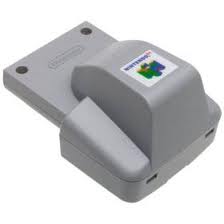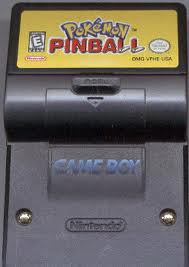Devices
Controllers didn't always provide the gamer with vibration or 'rumble'. It is a concept that has evolved in video game systems and controllers in both technology and creativity. Long before appearing on home systems, force feedback was used in arcade games for more than a decade, with early examples including Sega releases such as Fonz (1976), Astron Belt (1983), and Hang-On (1985).
 Nintendo 64's Rumble Pak
Nintendo 64's Rumble PakIn early 1997, the Nintendo 64 became the first system to provide the home video gamer with force feedback. The controller contained an expansion port, primary used to hold the gamer's memory card to save/load their game. During the life of the system, Nintendo developed two devices to expand the port beyond saving games. They developed the Rumble Pak and a GB Transfer Pak. The Rumble Pak required two AAA batteries. When triggered by code in the software, it made the controller vibrate. Nintendo included the Rumble Pak in their Star Fox 64 game. In the game if your ship blew up or hit the ground you would feel the impact in the controller. Including the Rumble Pak in the game was a great marketing move for Nintendo. It helped get the device into more homes which helped motivate game developers to add rumble features in their game. This innovation helped sell the system as it created separation between other systems on the market. It is often times included in 'Best video game innovations' lists found on the internet.
 Pokemon Pinball with built-in rumble
Pokemon Pinball with built-in rumbleWhile Nintendo 64's Rumble Pak was hugely popular with the people who played games as well the people who developed games, many developers wanted to ride the popularity into the handheld market which at the time was dominated by Nintendo's Game Boy Color. The disavantage of the Game Boy Color was the lack of any expansion port nor native support for force feedback in the system itself. If a developer wanted force feedback in their GBC game, they would have to include the technology into the cartridge itself. This resulted in bulky but pretty effective cartridge designs. The typical form factor of a GBC with force back was a shorten label to make room for an AAA battery. There are over 20 GBC games with built-in rumble. The more popular ones are Pokemon Pinball, Perfect Dark and Top Gear Rally.
 Sega Dreamcast's Jump Pack
Sega Dreamcast's Jump PackSega, the original pioneers of force feedback in the arcades, later improved on Nintendo's controller rumble concept. One of the issues with the Nintendo 64 controller was in order to use the Rumble Pak you had to remove the memory card. With the Sega Dreamcast controller, it contained two expansion ports in the controller. One for the memory card and another for various expansion's such as Jump Pack, microphone, etc. Technology remained the same although it no longer required an additional battery as the power was supplied by the controller itself.
 WarioWare Twisted with built-in rumble
WarioWare Twisted with built-in rumbleAfter a couple years of GBC dominating the handheld market, Nintendo released the Game Boy Advance. The system didn't include built-in rumble, one of the reasons was because Nintendo wanted to maintain a high battery life for the system. If developers wanted rumble, like the GBC they would have to include it in their game cartridge. I guess you can say the cost of adding rumble wasn't worth it for the developers for there are only two GBA games that have built-in rumble. Nintendo's Warioware Twisted and Drill Dozer.
 Nintendo Gamecube controller with built-in rumble
Nintendo Gamecube controller with built-in rumbleAfter Nintendo 64 started to lose market share, Nintendo was hard at work at developing their next console, the Gamecube. The Gamecube controller from the start had built-in rumble capabilities and powered by the controller. Along with it being built-in, the technology advanced in a way where the developers can now control the intensity of vibration. Other companies, such as Microsoft and Sony started to follow suite and having built-in rumble is considered par for the course.
 Nintendo's short lived Rumble Pack for the DS
Nintendo's short lived Rumble Pack for the DSThe Nintendo DS replaced the Game Boy Advance in 2004. When the NDS came out it was backwards compatible with GBA games and included a GBA cartridge slot on the bottom of the device. Developers quickly leveraged this catridge slot and re-purposed it. Arkanoid's paddle controller, Guitar Hero's guitar grip and Nintendo's Rumble Pak. Like the popular Pokemon Pinball GBA game before it, Nintendo included the rumble pak with their new Metroid Pinball game. The add-on device didn't really catch on and not alot of developers included code to provide force feedback pak. When Nintendo redesigned the Nintendo DS, they removed the GBA cartridge slot and thus killing their own rumble pak in the process.
Log in to comment